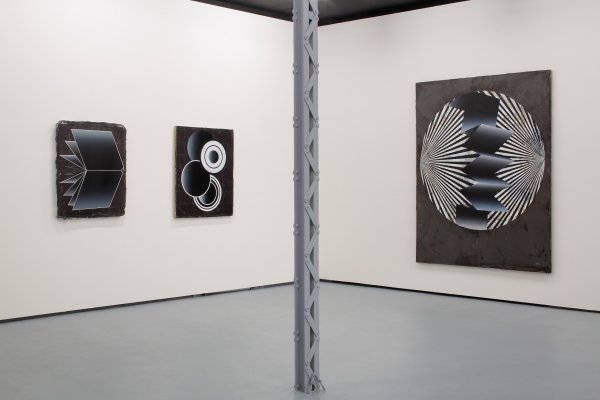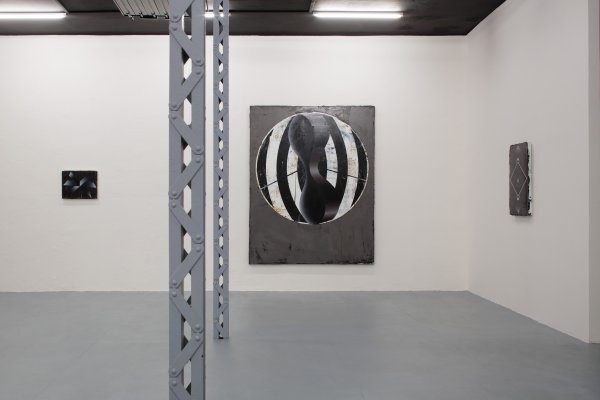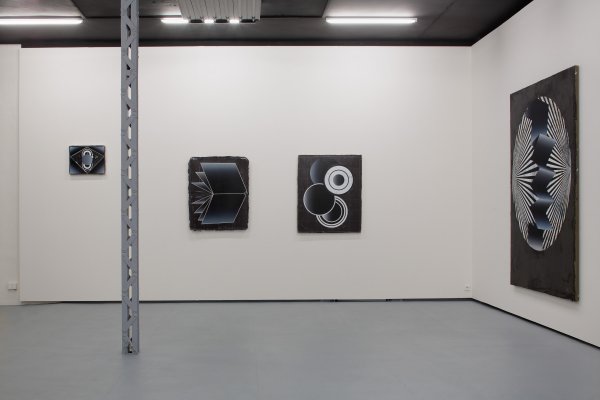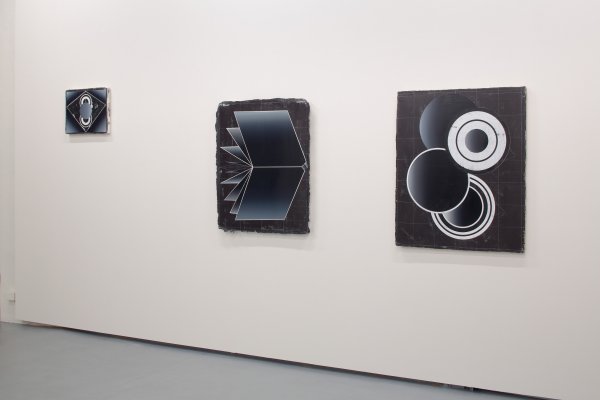Vladimír Houdek
Future Polis
7.2.2015–21.3.2015 Prague Curated by Cora Waschke- Text by Cora Waschke (EN)
- Text by Cora Waschke (DE)
- Text by Cora Waschke (CZ)
“We don’t know what the future will be like, but I anticipate it will be abstract.”
Vladimír Houdek
Symmetrical arrangements of concentric circles and polygons dominate the dark paintings in the Future Polis exhibition by Czech artist Vladimir Houdek.
The clearly delineated forms are centred before a shaded or checked background of fine pastel lines and take up the greater part of the painted surface. These geometric figures, which at first appear like graphics, present themselves on a massive-looking support. As smooth as their surface may be, the acrylic paint collects at the edges of the paintings, demonstrating with its encumbering weight the objectual quality of the works. The image becomes a panel, a relic from another time.
Counter-posing this perishable materiality is the timeless and universal symbolism of the circle: eternity and perfection.
Vladimir Houdek has long been fathoming the circle; as an element of modernity, as a base for “pure painting,” as an opening-up of pictorial space, as the epic centre of the image composition. In Future Polis the circle appears in the form of concentric discs and spheres. Since time immemorial the circle has governed and illustrated our concepts of the world, whether the concentric circles of the Christian heaven or the orbits of the planets. The alchemist Georg von Welling (1655-1727), referenced in one of the picture titles, sought to express the overlapping of the creation narrative and spatio-temporal dimensions of reality by means of circular forms. Houdek’s images, which combine circles and polygons in relation to a central point, follow thereby the principle of the mandala (Sanskrit: circle), which are intended to make visible the totality of the cosmos and at the same time depict the floor-plans of sacred buildings. In their sombre and striking, almost poster-like quality, the works in Future Polis are reminiscent of emblems that might derive from futuristic films such as Metropolis (1927) or Solaris (1972). Two major innovations are thematised and developed in these films: industrialisation and space travel. In the future city Metropolis machines run the living environment. In Solaris a planet that enables forces the space travellers to live in materialised memories takes over. In the work series Memory, the re-presentation of the past is depicted in the form of open books and fold-outs. In a large-format painting, that kind of a storage medium of knowledge such as this appears in a circle of radially expanding black-and-white lines. Comparable to a group of works by Francis Picabia from the early 1920’s, (Octophon, Conversation, Volucelle, etc.), classified as “late dada-machinist style,” an optical effect arises through the wavering of the lines that casts the objects into space. In Houdek’s work, subtly nuanced gradations of shading make the floating objects appear three-dimensional. However, apparent light reflections shape and modulate the surfaces and figures in an aesthetic rather than a natural manner. Here, the pictures correspond more to models than to illustrations. Houdek combines their sleekness with surfaces that seem to bear traces of mechanical working and at the same time can be interpreted as stellar nebulae. At this interface the images open up the infinite space of the cosmos in which planets hover, encountering the eye of the beholder like the eyes of an alien power.
Houdek’s paintings unite the materiality of image, the present and machine with the immateriality of illusion, the future and space. Future Polis touches on visions that have been operative at the latest since the emergence of modernity and on the anxieties bound up with them. The conquest of space takes place through machines. The fear of an artificial intelligence turning against humanity persists. Houdek’s choice of a modern, abstract formal language and combining it with stellar imagery seems like a look into the future that will retain its validity permanently.
„Wir wissen nicht, was die Zukunft bringt. Sie ist abstrakt.“
Vladimír Houdek
Symmetrische Anordnungen von konzentrischen Kreisen und Polygonen dominieren die dunklen Malereien in der Ausstellung Future Polis des tschechischen Künstlers Vladimir Houdek.
Die klar abgegrenzten Formen sind vor einem schattierten oder mit feinen Pastelllinien karierten Hintergrund zentriert und nehmen die Bildfläche größtenteils ein. Diese zunächst grafisch anmutenden geometrischen Figuren präsentieren sich auf einem massiv wirkenden Bildträger. So glatt ihre Oberfläche gehalten ist, an den Bildrändern sammelt sich die Acrylfarbe und demonstriert beschwerend die Objekthaftigkeit der Werke. Das Bild wird zur Tafel, zu einem Relikt aus einer anderen Zeit.
Dieser vergänglichen Materialität entgegen steht die zeitlose und universelle Symbolik des Kreises: Ewigkeit und Vollkommenheit.
Vladimir Houdek lotet die Kreisform seit langem aus, als Element der Moderne, als Grundfläche für „reine Malerei“, als Öffnung des Bildraums, als episches Zentrum der Bildkomposition. In Future Polis tritt der Kreis in Gestalt konzentrischer Scheiben und Kugeln auf. Seit Menschengedenken bestimmt und veranschaulicht er unsere Vorstellungen von Welt, seien es die konzentrischen Kreise des christlichen Himmelreiches oder die Umlaufbahnen von Planeten. Der Alchimist Georg von Welling (1655-1727), auf den einer der Bildtitel verweist, versuchte mit Kreisformationen die Überlappung von „Schöpfungsgeschichte und raumzeitlichen Wirklichkeitsdimensionen“ zu fassen. Die Bilder Houdeks, die auf einen Mittelpunkt hin Kreise und Polygone kombinieren, folgen darin dem Prinzip von Mandalas (Sanskrit: Kreis), welche die Ganzheit des Alls visualisieren sollen und gleichzeitig Grundpläne sakraler Gebäude zeigen können. In ihrer düsteren und fast plakativen Präsenz erinnern die Werke in Future Polis an Embleme, wie sie futuristischen Filmen wie Metropolis (1927) oder Solaris (1972) entstammen könnten. Zwei große Innovationen werden in diesen Filmen thematisiert und weitergedacht: Die Industrialisierung und die Raumfahrt. In der Zukunftsstadt Metropolis bestimmen die Maschinen die Lebenswelt. In Solaris übernimmt ein Planet die Kontrolle, der die weltraumreisenden Menschen in materialisierten Erinnerungen leben lässt. Die Vergegenwärtigung von Vergangenem zeigt sich in der Werkserie Memory in Gestalt von aufgeklappten Büchern und Leporellos. Im großformatigen Bild erscheint ein solches Speichermedium des Wissens vor sich in einem Kreis strahlenförmig ausbreitenden, schwarz-weißen Linien. Vergleichbar mit einer Werkgruppe Francis Picabias aus den frühen 1920er Jahren (u.a. Octophon, Conversation, Volucelle), die als „late dada-machinist style“ klassifiziert wurde, entsteht ein optischer Effekt durch das Flimmern der Linien, der die Gegenstände in den Raum wirft. Die schwebenden Objekte selbst wirken bei Houdek durch feinste Tonabstufungen dreidimensional. Scheinbare Lichtreflektionen gestalten und modulieren die Flächen und Figuren allerdings eher in ästhetisierter als natürlicher Weise. Dort entsprechen die Bilder mehr Modellen als Abbildungen. Deren Glätte kombiniert Houdek mit Flächen, die Spuren mechanischer Arbeit zu tragen scheinen und gleichzeitig als Sternennebel gedeutet werden können. An dieser Schnittstelle eröffnen die Bilder den unendlichen kosmischen Raum, in dem Planeten schweben, die wie Augen einer fremden Macht dem Blick des Betrachters begegnen.
Houdeks Malereien vereinen die Materialität von Bild, Gegenwart und Maschine, mit der Immaterialität von Illusion, Zukunft und Raum. Future Polis berührt spätestens seit der Moderne wirkende Visionen und auch die mit ihnen verbundenen Ängste. Die Eroberung des Weltraums geschieht durch Maschinen. Die Furcht vor einer sich gegen den Menschen richtenden künstlichen Intelligenz besteht.
Wenn Houdek eine moderne, abstrakte Formensprache wählt und mit stellaren Erscheinungen kombiniert, dann erscheint das wie ein ewig gültiger Blick zurück in die Zukunft.
„Nevíme, co nám budoucnost přinese. Je totiž abstraktní.“ Vladimír Houdek
Symetricky uspořádané sestavy koncentrických kruhů a mnohoúhelníků dominují tmavým malbám vystavené série obrazů českého umělce Vladimíra Houdka, která nese název Future Polis. Tyto jasně definované tvary jsou umístěny do středu maleb, před vystínované nebo do čtverců rozdělené pozadí tvořené jemnými pastelovými liniemi a zabírají větší část plochy obrazu. Tyto geometrické obrazce, které na první pohled budí dojem grafiky, jsou prezentovány na robustně vypadajícím masivním podkladu. Ať již je povrch akrylových barev jakkoli jemný, jejich masa nahromaděná na okrajích maleb svou hmatatelnou vahou podtrhuje materiálnost těchto děl. Obraz se stává jakýmsi panelem - památkou z jiné doby.
Jako protiváha této pomíjivé materiálnosti působí nadčasový a univerzální symbol kruhu představující věčnost a dokonalost.
Tématem kruhu se Vladimír Houdek do hloubky zabývá již dlouho. Představuje pro něj prvek modernosti, základ „čisté tvorby“ - jakousi bránu otvírající prostor obraznosti a epické centrum kompozice obrazu. Ve sbírce Future Polis se kruh objevuje ve formě koncentrických disků a koulí. Kruh již od nepaměti provází a pomáhá znázornit naše představy o světě jako takovém. Koncentrické kruhy nacházíme například ve vyobrazeních křesťanského nebe nebo oběžných drah planet. Alchymista Georg von Welling (1655-1727), na nějž jeden z obrazů odkazuje svým názvem, usiloval o vyjádření významového překrývání legendy o stvoření a prostorově omezené dimenze reality prostřednictvím kruhových forem. Houdkovy obrazy kombinující kruhy a mnohoúhelníky uspořádané vzhledem k centrálnímu bodu respektují zároveň princip mandaly (ze sanskrtu: kruh), jež má znázorňovat úplnost a dokonalost vesmíru a zároveň slouží jako předobraz, na němž vznikají půdorysy posvátných budov. Díla sbírky Future Polis jsou strohá a nápadně připomínají plakáty. Mohou být vykládána jako odkazy na symboly z futuristických filmů jako například Metropolis (1927) nebo Solaris (1972), v nichž jsou zachyceny a rozvíjeny dva významné aspekty moderního světa: industrializace a cestování do vesmíru. V městě budoucnosti Metropolis ovládají stroje životní prostor. Film Solaris zase pojednává o planetě, která umožňuje astronautům žít ve světě zhmotnělých představ. V sérii Memory (Paměť) je minulost znázorněna formou otevřených knih a rozkládacích příloh. Na velkoformátových malbách se takovéto médium pro uchování lidského vědění objevuje v kruhu paprskovitě se šířících černých a bílých linií. Podobně jako v sérii prací Francise Picabia z počátku 20. let minulého století (Octophon, Conversation, Volucelle a další) označovaných za „pozdní dada-mechanistický styl“ vzniká i zde vizuální efekt spočívající ve zdánlivém chvění linií, které jakoby vrhaly daný objekt do prostoru. V Houdkových pracích způsobuje jemně odstupňovaná gradace stínování dojem prostorovosti zobrazených objektů. Avšak odrazy světla tvarují a dotvářejí povrchy a obrazce estetickým, spíše než přirozeným způsobem. Obrazy zde odpovídají spíše modelům než ilustracím. Jejich hladkost je kombinována s povrchy nesoucími známky mechanického opotřebení, které však mohou být zároveň vnímány jako jakási hvězdná mlhovina. Na tomto rozhraní nám obrazy otvírají nekonečný prostor vesmíru se vznášejícími se planetami, pro něž jsou oči pozorovatele očima návštěvníka z kosmu.
Houdkovy malby spojují materiálnost obrazu, přítomnosti a stroje s nemateriálností iluze, budoucnosti a prostoru. Future Polis se dotýká vizí, které vznikly před nedávnem, na úsvitu moderní doby, a jsou živeny obavami s nimi spojenými. Dobývání vesmíru zajišťují stroje. Strach z umělé inteligence, která se vymkne kontrole a obrátí se proti lidstvu, přetrvává. Houdkova volba moderního, abstraktního formálního jazyka v kombinaci s vesmírnými výjevy působí jako pohled do budoucnosti, který si navždy uchová svou platnost.

















